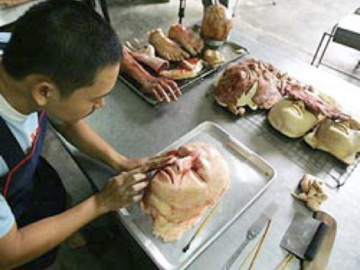
Kittiwat Unarrom is the son of a baker and has a masters degree in fine arts. His medium is bread; his subject is human flesh. Since 2006, he has been selling his wares impaled on meat hooks or on plastic-wrapped styrofoam trays behind a glass case in his “Body Bakery” in Ratchaburi, Thailand.
For pictures, text, and a video (in Thai) about the Body Bakery, check out this post via Shape+Colour. NOTE: this may be scary for children.
He is a virtuoso of the grotesque. The skill and attention to detail are impressive, but I am not sure what to make of his work. I can find little information about his intention and it is unclear whether this is primarily due to a language barrier or because he is not one to make artist statements.
His work makes me, coming from a Western perspective, think of the flesh-to-bread transformation of the Catholic Holy Communion, Hansl and Gretl, and Halloween haunted houses where grapes mimic eyeballs and spaghetti moonlights as intestines.
From what I was able to find, he is inspired by the Buddhist concept that one shouldn’t be misled by appearances; what you see may not be true to what you thought. He is quoted as saying, “Of course, people were shocked and thought that I was mad when they saw the works. But once they knew the idea behind it, they understood and became interested in the work itself, instead of thinking that I am crazy.”
Again, maybe it’s a translation issue but this feels like an overly simple and thus frustrating answer. If the goal was to push the idea of ‘seeing is believing’ with home baked trompe l’oeil, there are many different directions to go with this. The painstaking realism of his goods and the faux-cannibalism they imply is an unnerving aspect of his work that this statement doesn’t really address.
I’d be really interested to know more about the interaction with his customers, their experiences buying his products, and whether his showroom functions more closely to a gallery or to a bakery. Do most come in for the novelty or are there repeat clients? What is the life of the ‘body bread’ after it leaves the store—is it served as ‘normal bread’ in a sandwich? What happens to pieces that aren’t sold by the end of the day? Bread is quick to mold in a humid climate… How are the pieces priced compared to a regular loaf?
DISCUSSION: What do you think about the Body Bakery?